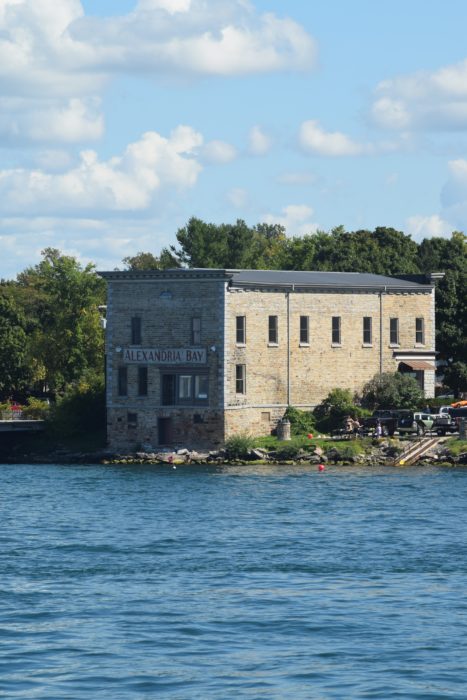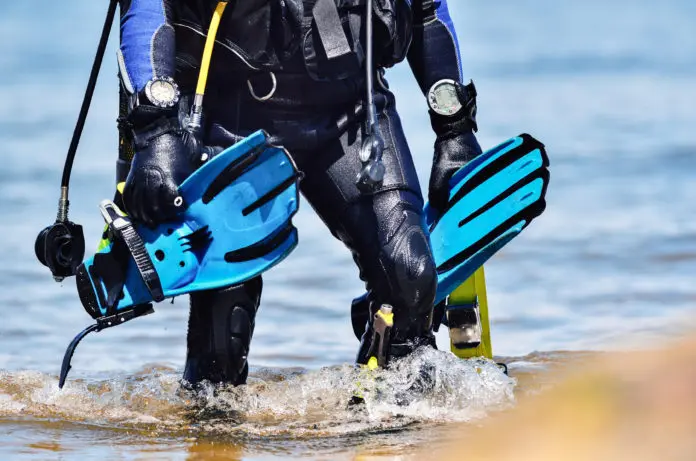Until recently, almost all of my nearly twenty years of diving has been boat dives. Last year, I had an opportunity to do a dive in the Bahamas, that was a shore dive. It was a shallow dive just to 30 feet (ca. 9 meters) in a protected lagoon. I was traveling with non-diving friends, so I did not have a dive buddy with me. The dive was just two other divers and the dive guide. The dive briefing dismissed the need for dive buddy teams as it was a follow the leader dive. We did our equipment checks and put our gear on at the dive shop about a 100 yards (ca. 91 meters) across the beach from the water. The beach was the type of sand that many find difficult to walk in, adding our gear made it even more of a challenge.
After we reached the water, there were another 25 yards (ca. 23 meters) or so until the water was deep enough to put on our fins. It quickly became apparent the benefit of a dive buddy for a shore entry. Doing it alone took me a bit of time and made me feel like I knew nothing about diving. The other divers were waiting on me by the time I finished. A simple change in environment made a simple task daunting.
A few minutes of snorkeling took us to waters deep enough to being our dive. The dive was along a small reef and after an hour we found we were ready to walk to shore. While the tanks were lighter, it was still a good workout in the shallow water and across the beach back to the dive center.
I will not say that dive made me a convert, however, I have done mostly shore dives since then. It has made me realized that with your own equipment and a dependable dive buddy, shore diving could be all around you. Maybe, like I was, you are just overlooking it.
There are a number of world-class destinations that have outstanding shore dive sites, Bonaire being one of them.
Shore Diving 101
As a boat diver, we may experience many “flavors” of boat diving. Anything from small six pax and RIBS up to “cattle” boats with hundreds of divers. How you set up your gear, how you enter and exit the water, and your degree of comfort during the surface interval and when transporting will be different depending on the boat. When boat divers think of shore diving, we might not appreciate the differences that the entry and exit may present.

Shore Survey
How you plan on entering the water and more importantly exiting the water is one of the most critical points at some dive sites. A beach dive may be as easy as walking in and out of the water. However, an entry point with many rocks and a surf may be nearly impossible to exit. The surf might treat you like a dog does a rag doll, throwing you around without a care. Currents may present a problem as well. They can push you past or away from your exit point. You may need to check tide tables. This is an extreme example but at the Bay of Fundy in Nova Scotia, the difference between low and high tide is an amazing 38.4 feet.
Before entry, fix a set of reference points, one behind the other. Remember to verify it while in the water. It may look different from the water level.
Where you don our gear, is also a consideration in your planning. Do you assemble your gear at your car and wear to the entry point? If so, do you need a rest period before entering the water? Or do you bring a tarp, set it near the entry point, then make a few trips bringing things over. I have seen some very nice beach carts lately. They make moving over the sand very easy. I have already written a letter to Santa telling him which one he can bring me.
On a boat, the rule is to always have someone on board the boat. You should have shore support for a shore dive as well. Not only will they be useful looking at your belongings, but they can assist in your return as well as notify others if you become overdue from your dive. On a crowded beach, they can keep you from roaming aimlessly looking for your stuff.
I have seen a definition of shore diving that states the only way to start a shore dive is by wading. A purist might not consider a pier or a jetty a shore dive. Even diving a spring or a cenote may not meet their view. I would group them together with a shore dive. Depending on the dive site, some of these may use entries the same as those used on a boat. You could do a back roll, a controlled seated entry or even a giant stride. My favorite pier dive was a giant stride entry to the water some 15 feet (4.57 meters) below. The exit required you to remove your gear in the water, attach it to a rope and ascend a ladder as someone pulls the gear up to the pier. Piers provide some of the best diving in the world.
Get Out and Dive More
Having your own gear and a local dive buddy, shore dives can be an inexpensive means to expand your diving. Boats are expensive to own and operate. If you take a dive charter or join a dive from a dive center, you will be paying a portion of those boat cost, including the crew. Doing shore diving, you need to pay for your breathing gases and maybe a tank rental. I have experienced a number of outstanding shore dives, including shipwrecks. I have a list now of twenty local dive sites to start diving in the spring. Quite a few small boats and even a flooded town. I also have a few places I want to explore that are not known dive sites. Who knows what I may find.

